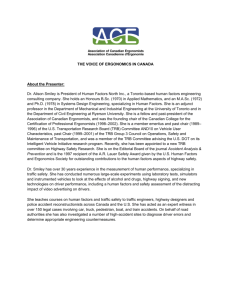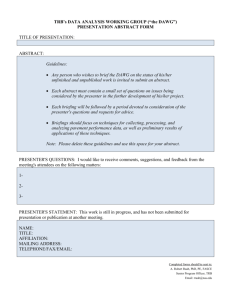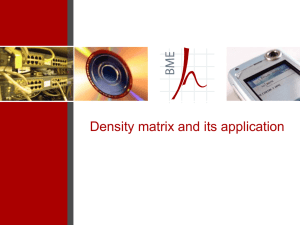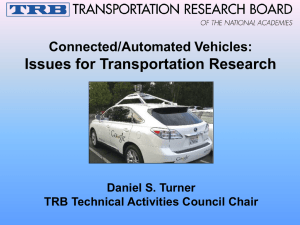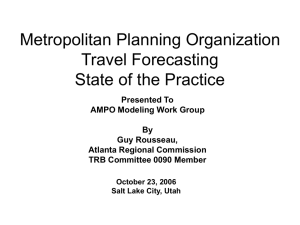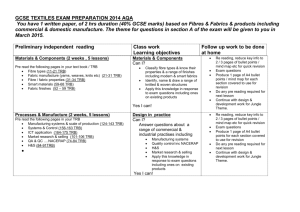2009 COMMITTEE CHAIR TOOLKIT FOR SUCCESS Transportation Research Board
advertisement
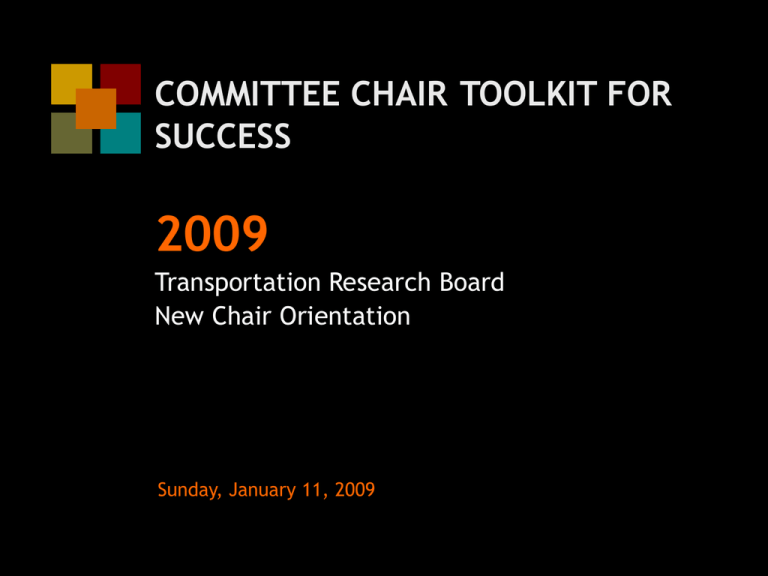
COMMITTEE CHAIR TOOLKIT FOR SUCCESS 2009 Transportation Research Board New Chair Orientation Sunday, January 11, 2009 What Do TRB Committees Do? Stimulate and synthesize research Keep transportation communities apprised of research findings Review and recommend papers for publication Co-sponsor special activities BUT THAT IS NOT THE REAL MESSAGE TRB Committees Provide Opportunities Networking with fellow transportation professionals Staying current on emerging issues Participating in the advancement of the practice PROVIDING THESE OPPORTUNITIES TO YOUR MEMBERS IS WHAT YOUR WORK AS CHAIR IS REALLY ABOUT! TRB Committee Structure Technical Activities Council TRB committees are combined into Groups and sometimes in Sections The combination is based on the committee topic and scope The Sections and Groups provide an opportunity to work together on crosscutting topics and activities Group Section Group Section Task Force Committee Subcommittee Elements Needed for Success Strategic plan Communication tools Leadership skills Understanding of administrative requirements Strategic Plan A Strategic Plan Focuses the Committee Mission Why does the committee exist? Scope Why does the committee exist? Goals What does the committee want to achieve? Strategies How will the goals be achieved? Action Plan What is planned for the next three years to accomplish goals & strategies? Strategic Plan Development See Page 37 of the Leadership Guide for more information: http://www.trb.org/Activities/About/ChairsCommittees.asp Update every 3 years—coordinate with incoming chair if rotating within triennial period Use as an activity to engage committee members TRB Leadership adopted a new strategic plan in June of 2007 and may be found at http://onlinepubs.trb.org/onlinepubs/general/trb_strategic_pla n.pdf Strategic Plan Development What’s worked? What hasn’t? Ideas to share? ? ? Communication Tools Potential Communication Strategies Newsletters Committee Chair Letters List serve Websites Teleconferences The specific technology or media is less important than communicating regularly! Newsletters Issue semi-annually or quarterly Post on website or member published and distributed Committee Chair Letter to Members and Friends Less effort than newsletter, but can “grow” into newsletter Listserves Fosters dialogue among committee members and friends via e-mail Requires maintenance and updates by the host organization Committee Websites Committees are responsible for accuracy and maintenance TRB will link TRB On-Line Directory to the committee home page Preferred style reference is Elements of Style for Web Design by Christine A. Quinn Contact your committee staff person to have the page connected Conference Calls Provides additional opportunity for conduct of committee business between meetings TRB Leadership Guide provides tips for conveners on Page 69: http://www.trb.org/Activities/About/ChairsCommittees.asp Consult with your TRB Staff Representative for additional assistance Communication Strategies What’s worked? What hasn’t? Ideas to share? ? ? Leadership Skills Ultimately, It’s About Leadership... Selecting committee members Encouraging participation Delegating responsibility Running organized meetings Communicating early and often Selecting Committee Members Be selective!!! Don’t accept every applicant Include members that bring different expertise or connections to other communities. Contact leaders in the field and follow up on their suggestions Tell prospective members what you expect and make sure they can make the necessary commitment Encouraging Participation Establish well-defined, challenging and reasonable tasks Link assignments with each individual’s interests Set deadlines and follow up Praise accomplishments in private and public Make sure each member is contributing Follow up with new participants to encourage additional participation and commitment Delegating Responsibility The more independent subcommittees or work groups the better! Activity generates more activity Don’t feel you must be personally involved in every task Monitor, guide, cheerlead Stay connected to ensure the committee need is being met Broaden the leadership base Delegating Responsibility Consider appointing members to some specific duties, such as: (continued) Secretary Newsletter editor/web master Research subcommittee chair Paper Review Coordinator Annual meeting chair Liaison chair Other program or activity chair Succession planning. It may seem a long way off, but it is important to be aware of those that might be good candidates for future committee leadership. Running Organized Meetings Prepare and distribute an agenda in advance Include presenters’ names and timeframes for each item Include reports on ongoing tasks and allow for committee/friends input to keep things lively Include discussion items and encourage informal interaction Avoid debates Maintain a sense of humor! Stay on schedule Communicating Early and Often Contact those engaged in relevant research Connect with external sources of relevant information Communicate, communicate, communicate! With the committee as a whole With subcommittees and work groups One-on-one with subcommittee leaders, existing and prospective members With your TRB staff contact Committee Leadership What’s worked? What hasn’t? Ideas to share? ? ? Understanding of Administrative Requirements At First It Seems Like a Private Club With Secret Rules... But the administrative information is readily available TRB website has comprehensive on-line resources at Leadership Guide http://www.trb.org/Activities/About/ChairsCommittees.asp On-line paper review system guide Calendar of important dates TRB staff and committee chair directory And TRB staff is ready and willing to help! Administrative Highlights: Committee Membership Chair nominates members after discussion with TRB staff Appointments are made by TRB Executive Director for a 3-year term Administrative Highlights: Committee Membership (continued) A committee is limited to 25 members, with some exceptions Unlimited number of Emeritus Members 2 Young Members (35 years or younger) 5 International Members (non-US) Unlimited number of “friends” There is no limit to the number of young members or international members – each committee can appoint 2 and 5 that do not count against the member limit TRB is committed to a one-third rotation in membership each third year Administrative Highlights: Annual Meeting Planning TRB staff coordinate with chairs to schedule sessions Paper or Presentation sessions (approximately two per committee) Poster sessions Joint committee sessions (within the committee session limit) Committee and Subcommittee Business meetings Session Planning webinars are held each year Administrative Highlights: Mid-year Meetings Not all committees hold mid-year meetings Locations determined several years in advance Generally many committees meet together Some individual committees hold meetings with local sponsors TRB staff coordinate with chairs to schedule business meetings, plenary sessions, and joint committee workshops Administrative Highlights: Meetings and Minutes Meetings are open unless the chair designates an executive session Visitors and “friends” may take part in discussions but may not propose motions or vote Minutes are no longer confidential and may be widely distributed Administrative Highlights: Paper Review Process Chair or appointee selects paper reviewers 3 reviewers per paper (at the very least) Reviewer’s names to be kept confidential Chair or appointee notifies the author of evaluation result Paper review webinars are held each year to help you navigate the system Administrative Highlights: Paper Review Process (continued) In advance of the “August Avalanche” Have a plan—who, which, where? Volunteer reviewers—commitment and interest An updated mailing list—phone, fax, e-mail Internal deadlines Alternatives structures Committee Chair Subcommittee Paper Review Coordinator or Publications chair Administrative Highlights: Travel Expense Reimbursement TRB policy is to help defray travel costs of committee chairs to either the annual or mid-year meeting when they cannot obtain funds elsewhere and to the extent funds are available TRB will not cover committee member or speaker expenses Administrative Highlights: Specialty Conferences and Workshops Approval of the TRB Executive Committee must be obtained prior to development Must be self-supporting (registration fees and/or outside funding) Governing Board of the National Research Council must approve events sponsored with outside funding Remember the Resources TRB Division A Leadership website: http://www.trb.org/Activities/About/ChairsCommittees.asp On-Line Directory (full contact information for all TRB members) Email list for all your committee members Printed Calendar and …. If all else fails……. Call or e-mail your TRB staff officer Peter Kim Tom Christy Elaine Joedy Martine 202-334-2983 202-334-2968 202-334-2907 202-334-2970 202-334-3206 202-334-2167 202-334-3177 pshaw@nas.edu kfisher@nas.edu tpalmerl@nas.edu cgerencher@nas.edu eking@nas.edu jcambrid@nas.edu mmicozzi@nas.edu Or their project assistant Freda Morgan Brie Schwartz Mary Kissi Matt Miller 202-334-2965 202-334-3015 202-334-3205 202-334-2608 fmorgan@nas.edu bschwartz@nas.edu mkissi@nas.edu mamiller@nas.edu
